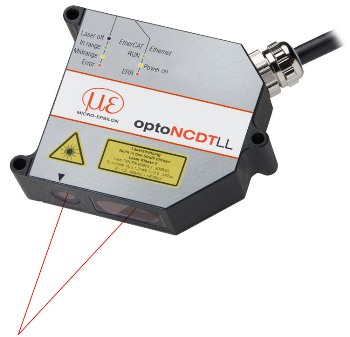Precision sensor manufacturer Micro-Epsilon has launched a new non-contact laser line displacement sensor, which is ideal for the high speed measurement of shiny metallic and rapidly changing, rough or other difficult-to-measure surfaces.
 optoNCDT 2300LL sensor
optoNCDT 2300LL sensor
Rather than using a spherical or point-shaped laser spot, the new optoNCDT 2300LL sensor uses a unique laser line and special software algorithms to filter out any interference caused by very small (sub-micrometre) surface defects on shiny objects such as polished metals, mild steel and rubber. The sensor uses a special cylindrical lens that widens the laser spot to an oval shape. Although this shape appears as oval to the human eye, the actual shape is a very small line. Measurements using this laser line are then averaged using Micro-Epsilon’s patented software algorithms, so that any interference caused by surface roughness, defects, indentations or holes down in the sub-micrometre range – are dramatically reduced.
An ideal application for the optoNCDT 2300LL is therefore on structured surfaces, where the distance to the surface and not the structure itself need to be measured. The distance measurement should not be influenced by the structure of the surface, but instead should provide a constant, reliable value of the distance from the target.
The optoNCDT 2300LL is a self-contained laser displacement sensor that requires no separate controller. The sensor provides an extremely high measuring speed of up to 49.02kHz. Although competing sensors in the market claim to offer similar measuring rates and resolution, the optoNCDT 2300LL is the only sensor that offers such a high measuring speed and an integral controller. Whilst some competing sensor manufacturers offer laser sensors with similar measuring speeds and resolutions, their high resolution is only achieved by applying a high averaging factor, which then reduces the dynamic speed of the laser. The optoNCDT 2300LL achieves high resolution and high measuring speeds without any averaging.
A-RTSC Feature
The optoNCDT 2300LL uses Micro-Epsilon’s new A-RTSC (Advanced Real Time Surface Compensation) technology, which enables the sensor to automatically compensate in real time for difficult-to-measure surfaces. A-RTSC is a further development of Micro-Epsilon’s patented RTSC feature, which, when combined with high-speed software algorithms, dramatically reduces signal noise at high measurement speeds. When users need to measure against a shiny surface, for example, they ideally require a sensor that is able to automatically adjust the laser pulse duration (or laser on time) of the sensor to give them the optimum exposure time on the CCD for that particular surface. This, in turn, provides a higher accuracy measurement due to lower noise level on the output signal.
The sensor also offers a range of interfaces including Ethernet, EtherCAT, RS422 and analogue output via the CSP2008 controller. The sensor can now be configured remotely by using a web browser interface. This direct connection means the user can store parameters for a particular application, which can then be uploaded to one or multiple sensors, reducing set up time considerably. The sensor also provides various options for signal processing and data output, including peak selection (peak-to-peak), masking of the video signal, data reduction, averaging, exposure time, error status, time stamp, filtering and statistics (min and max).
The optoNCDT 2300LL is available in four models with measuring ranges from 2mm up to 50mm. Resolution is down to 0.3µm and linearity is down to ± 0.6µm. Data output is via Ethernet, RS422 or EtherCAT. The sensor is also extremely compact, measuring just 80mm by 75mm by 30mm.
For more information on Micro-Epsilon’s optoNCDT 2300LL sensor, please visit www.micro-epsilon.co.uk or call the Micro-Epsilon sales department on 0151 355 6070 or email: [email protected]